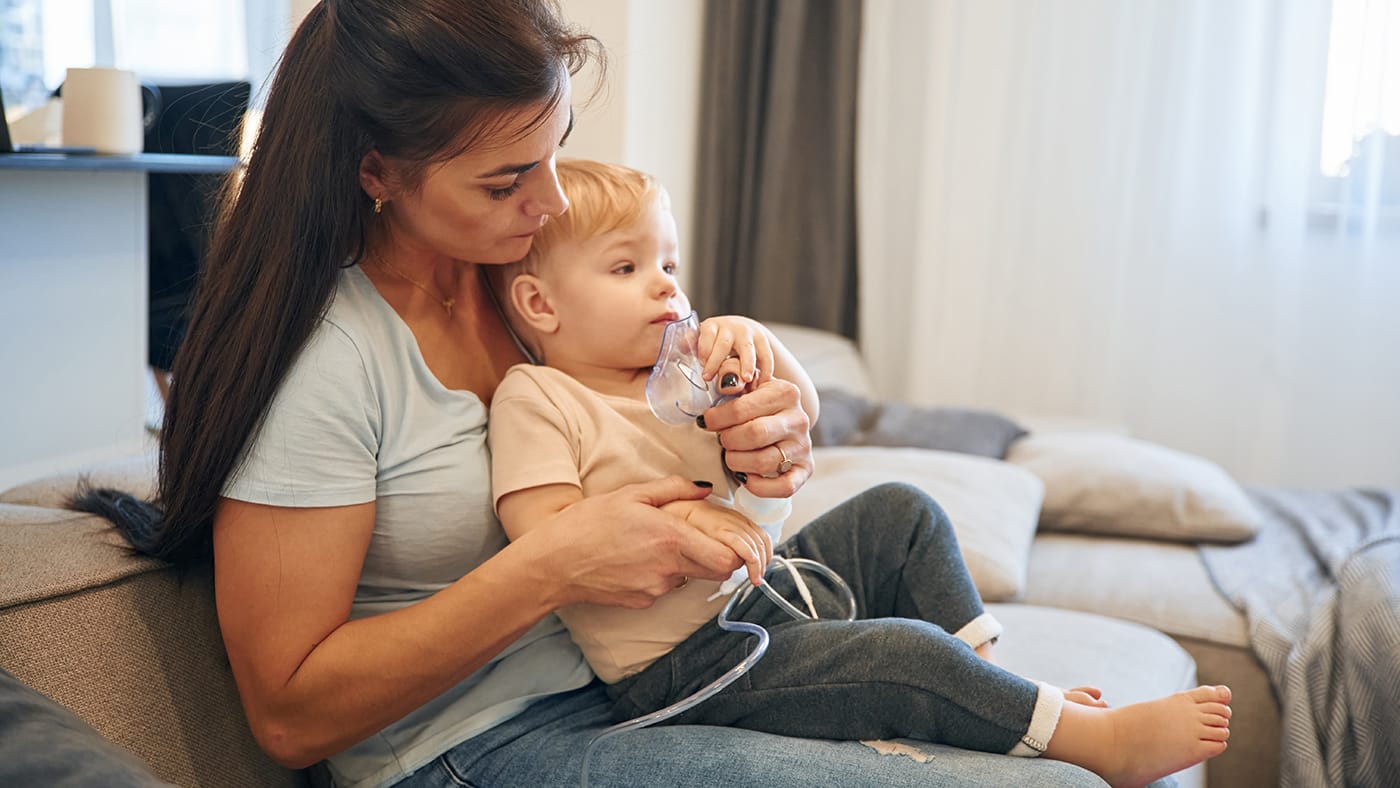RSV, short for respiratory syncytial virus, is a common respiratory virus that infects the nose, throat, and lungs. Usually, RSV only causes mild, cold-like symptoms and subsides on its own, but infants and adults with certain risk factors are at greater risk of developing severe RSV symptoms. Infections are most common in the fall and winter, and immunization is recommended to protect infants and young children to protect them during their first or second RSV season.
When is the RSV season in Utah?
Utah’s winters are world famous. People travel from all over the globe to see the state’s white-capped peaks and hit the slopes for the greatest snow on Earth. But the winters also bring an increase in respiratory illness.
RSV is highly contagious and impacts a significant proportion of young children. According to the American Academy of Pediatrics, between 1% and 3% of children in the United States under 12 months of age are hospitalized with RSV every year. RSV can be spread anytime, but it’s most common in the cold & flu season which, in Utah, begins a couple of weeks after school begins in late August and gains momentum in October when the weather drives us all indoors.
Utah typically sees its highest rates of RSV transmission during the winter and spring months, particularly from January to March.
When does the RSV season end in Utah?
An RSV infection can happen at any time but, like other respiratory illnesses, RSV is most common during the cold winter and early spring months. The RSV season typically begins in October, and The risk of infection declines toward the end of March or early April, as the weather starts to warm up.
Signs of RSV in Babies
Most infants and young children will only experience mild, cold-like symptoms as a result of RSV. However, some babies (especially those experiencing their first infection) may develop lower respiratory tract disease, including pneumonia and bronchiolitis. In fact, RSV is the most common cause of bronchiolitis and pneumonia in children younger than 12 months old.
Early Signs of RSV (Infants 0-6 Months)
- Stuffy/runny nose.
- Light or intermittent cough.
- Slight fever or even no fever.
- Decreased feeding or appetite.
- Increased sleepiness (especially at 0-3 months)
- Increased irritability (especially 3-6 months)
Severe symptoms, often requiring a trip to the emergency room or hospitalization, are most common in newborn babies to six months old. That’s because kids have smaller airways, which can be more heavily impacted by viruses and mucus in the throat and lungs.
When to Call Your Pediatrician
- Your child’s cough is getting worse or sounds deeper or more frequent.
- Breathing is faster than usual (but not labored or with blue lips—that’s an emergency).
- You hear mild wheezing or crackling sounds in the chest.
- Your child is breathing through the mouth because the nose is too congested.
- Any fever (under 2 months) or fever over 100.4 (over two months).
- Drinking or feeding has dropped noticeably.
- Fewer wet diapers or signs of dehydration like dry lips, sunken soft spot.
- Noticeable fatigue, irritability, or trouble sleeping.
Call 911 or go to the ER immediately if your baby:
- Breathing is labored (grunting, retractions, flaring nostrils).
- Lips, tongue, or skin look blue or gray.
- Child is very sleepy, limp, or unresponsive.
- Not urinating for 8+ hours or cannot keep fluids down.
How to Prevent RSV in Babies
Along with vaccination, a little extra diligence around hygiene during cold and flu season can protect your baby—and yourself—from a variety of easily-spread viruses.
Like many other respiratory viruses, RSV spreads when an infected person coughs, sneezes, or speaks, delivering droplets of mucus or saliva into the air. Those droplets carry copies of the virus, which can come into contact with someone else and infect them. RSV can also be passed if an infected person touches objects or surfaces with unwashed hands.
Along with vaccination, a little extra diligence around hygiene during cold and flu season can protect your baby—and yourself—from a variety of easily-spread viruses.
Practice Excellent Hand Hygiene
- Wash your hands often with soap and warm water for at least 20 seconds, especially after touching public objects like door handles, pay terminals, and shopping carts.
- Use alcohol-based hand sanitizer when soap and water aren’t available.
- Encourage older siblings and caregivers to do the same.
Limit Exposure During RSV Season
- Avoid close contact with anyone who has cold-like symptoms.
- Keep babies away from crowded places during peak RSV months (typically fall to early spring).
- Encourage sick family members to wear a mask or stay apart until they’re well.
Clean & Disinfect Surfaces
RSV can live for hours on hard surfaces like countertops, toys, and crib rails.
- Disinfect high-touch areas daily (doorknobs, toys, phones, changing tables).
- Wash bedding, blankets, and plush toys regularly in hot water.
Keep Your Baby Away from Secondhand Smoke
Exposure to tobacco smoke increases the risk of RSV severity and risk of hospitalization.
- Avoid smoking or vaping near infants or in enclosed spaces they occupy.
Vaccines for RSV
In addition to everyday precautions like washing your hands and staying home when you’re sick, there are two vaccines that lower the risk of infection and help protect young children from illness. The CDC recommends parents use one of the following:
- An RSV vaccine given to mom during the last trimester of pregnancy (Abrysvo).
- An RSV immunization offered to infants and some at-risk older babies (Beyfortus).
Happily, most infants don’t need both, but here’s what you need to know about the RSV vaccine options.
RSV Vaccine for Pregnant Women
Abrysvo is the only maternal vaccination for RSV recommended by the CDC for pregnant women between 32 and 36 weeks of gestation. After you receive the vaccine, your body produces antibodies that protect you and your baby against RSV. The vaccine given to expecting moms protects the baby for about six months after birth, with the strongest protection being those first three months. For that reason, moms are usually offered this vaccine between 32 and 36 weeks during RSV season.
If you weren’t eligible to receive a vaccine before delivery, talk with your baby’s pediatrician about immunization options. Not every baby needs the Beyfortus RSV vaccine, but it’s most commonly recommended for infants under eight months who are entering their first RSV season.
Beyfortus Vaccine for RSV
Beyfortus, also known as nirsevimab-alip, is a relative newcomer, approved by the FDA in 2023 for use in the prevention of RSV in babies up to 24 months old.
Beyfortus is a monoclonal antibody that uses lab-made proteins to mimic the body’s immune response, instead of a dead or damaged virus. The vaccine is delivered in a single intramuscular injection either before or during your baby’s first RSV season.
While vaccination doesn’t completely eliminate the risk of RSV infection, it does reduce it significantly. In clinical trials, babies who received the vaccine were approximately 70% less likely to become infected. Side effects are usually mild, like a small rash or skin reaction at the injection site.
The arrival of cold and flu season understandably makes parents nervous. The good news is, the vast majority of babies won’t have a serious run-in with RSV. If they do, there are options to help you treat symptoms at home. But, you’re already on the right path just by looking ahead. Your extra prevention efforts will go a long way to keeping your entire family healthy this winter.
Need after-hours RSV care?
Our Layton pediatric office is open until 10pm Monday through Friday and until 9pm on weekends. Call or text to book an appointment: 801-773-8644.
Local Resources for adult RSV & Flu Vaccines:
Sources:
- https://www.lung.org/lung-health-diseases/lung-disease-lookup/rsv/treatment
- https://www.cdc.gov/rsv/about/index.html
- https://epi.utah.gov/respiratory-syncytial-virus/
- https://healthcare.utah.edu/healthfeed/2020/01/abcs-of-rsv-signs-symptoms
- https://healthcare.utah.edu/healthfeed/2023/11/three-viruses-watch-winter




